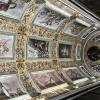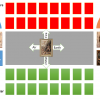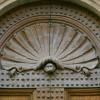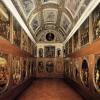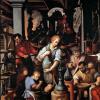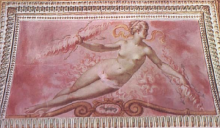Studiolo of Francesco I: The Fire Wall
Commentary
The Studiolo was structured according to the four elements, with earth and air being displayed at the small ends of the rectangle and fire and water at the long ones.
Amongst these, it is doubtless that fire played an important role in Borghini's iconography. Fire featured in Francesco Morandini's painting of Prometheus and Nature in the middle of the 'sky' ceiling of the Studiolo, which lay the core of the Studiolo's ideology. Prometheus, the titan who stole the fire from the gods, is shown as holding a fire stalk. The link between the fire and his supposed role as the inventor of all arts is evident. Borghini described fire as the most efficient and operative of elements.
The fire that Prometheus holds may not be an ordinary one; it is a livening fire, whose reddish hues are cast on the faces of Prometheus and Nature, and also the many animals portrayed in the painting. Red is also predominant in the personified image of 'Fire' as element.
On the Fire wall, Borghini envisaged two statues of deities that were connected to the element of fire: Apollo and Vulcan. Apollo was described as the god of light, heat and colour; as sun god, he is also linked with medicine (888). The link between Apollo and medicine is visually rendered by Domenico Buti's Apollo, Aesculapius and Chiron, which was probably meant to lie just beneath Apollo's statue, though the reconstruction strangely placed it elsewhere.
If Apollo represented 'fire' in the celestial realm, Vulcan portrayed it in the subterranean world.
His is the craftsman's fire, and this is clearly depicted in the oval painting just below Vulcan's statue, The Forge of Vulcan by Domenico Cassini.
In between the two gods and their worlds above and below, the earthly uses of fire are portrayed in a series of paintings that focus on artisan activities sponsored by the Medici family. Borghini did not prescribe these in as much detail as the ceiling paintings and statues, but suggested the combination of workshop images with those of historie, by which he means mythological stories or popular tales, particularly those originating from Pliny the Elder's Natural History.
Several of these paintings show Francesco I in the workshops, sometimes working in them himself (famously in Stradanus's painting The Alchemist's Laboratory). This confers an element of realism on these depictions, in stark contrast with the mythological images.
This is the more so as several testimonies from the era attest that Francesco was very interested not only in sponsoring scientific and artisan activities but also in performing them himself. Indeed, while the Studiolo was being erected, Francesco also commissioned a 'house of nature', the Casino di San Marco, a proto-scientific institution that included various workshops and alchemical laboratories. Here Francesco worked and developed, most famously, the recipe for the Medici porcelain.
Commentary: Georgiana Hedesan (Jan-Feb 2022).

